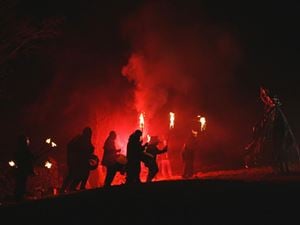
Landing on February 1st, Imbolc—pronounced “im-olk”—is an ancient Gaelic festival that celebrates the imminent coming of spring. The word “Imbolc” translates to “sheep’s milk” in Old Irish—lactating ewes were traditionally taken to be a sign that spring was on the way. Residing at the halfway point between the winter and spring equinoxes, Imbolc is a reminder that, although we’re in the coldest part of winter, spring is coming and life will soon flourish once again.
This celebration is extremely old, appearing from the 10th century and onward in some of the earliest Old Irish Literature, and was once one of the four important pagan seasonal festivals, which included Samhain, Beltane, and Lughnasadh. For these people, this was one of the coldest and darkest times of year, when people longed for warmth.
Celebrating Imbolc
The festival of Imbolc spanned from sunset to sunset, which means that celebrations would technically begin on the 31st of January. Imbolc being a celebration of warmth and hearth and home, celebrations would include bonfires special foods, candles, and hearthfires.
The lighting of fires and candles represented the impending return to warmth, as well as the now-increasing power of the sun.
Holy wells were also a part of traditional Imbolc celebrations, and visitors to these wells would pray for good heatlh while walking “sunwise”—meaning clockwise—around the well, leaving offerings of coins and strips of cloth. These holy wells were thought to be inhabited by powerful guardian spirits which could grant blessings to people’s homes, families, and fields.
Imbolc was also a time for weather divination, and it is from this that we inherit our modern-day North American Groundhog Day.
An old Scottish Gaelic proverb, translated into English, illustrates the Imbolc tradition of watching to see if snakes came out of their winter dens in order to predict the length of the winter.
The serpent will come from the hole
On the brown Day of Bríde,
Though there should be three feet of snow
On the flat surface of the ground
Saint Brigid
Imbolc is also known as Brigid’s Day, which refers to the Celtic goddess of fertility. This goddess was later Christianized as Saint Brigid when the Catholic Church had difficulties getting the people to abandon their old gods.
This goddess symbolized the light part of the year, and the energy which brought people through the harsh winter season and into spring, and so her presence was prominent during Imbolc.
According to lore, Brigid would come to virtuous households, blessing the inhabitants on Imbolc Eve. Celebrants would symbolically invite her into their homes, even making a bed for her. A rush-carrying family member of each household, representing Brigid, would circle the home three times, requesting entry. On the third attempt, the family member would be invited in, a meal would be served, and the rushes made into crosses or a bed.
Before going to bed, many people would leave pieces of clothing or cloth outside to be blessed by Brigid, which were then thought to have the power to heal and protect.
Often, a representation of Brigid—a doll called a Brídeóg—would be paraded by singing groups of young women, the doll made from rushes and clad in cloth and flowers.
These girls would visit every house in their community, where they would be given either food or more decorations for the Brídeóg. After the procession, they would dine in a house with the Brídeóg set in a place of honor, and they would, later, put it to bed and sing to it.
A type of cross called a “Brigid’s cross” was frequently made at Imbolc. This cross is made of rushes woven into a cross with four equally long arms, and was hung over windows and doors to welcome Brigid and offer protection from fire.
Later, when Brigid was made into a saint by Christians, her nuns would maintain a “perpetual fire” in her honor, situated at the center of a circle of hedges which males were not allowed to cross. No matter her form, Brigid never shed her association with her essential elements—fire, light and warmth.
Contemporary Imbolc
Today, little remains of Imbolc’s original celebrations, but it is still observed by some Neopagans as a religious holiday. These celebrations vary widely, with some seeking to preserve tradition, while others pull together elements from many different sources to create wholly new festivals.
The secular world, too, gets in on the fiery fun, most notably with the Marsden Imbolc Fire Festival in the UK. This tradition began in 1993. Angie Boycott-Garnett, the organizer of this event, describes its origins, saying “We wanted to put on an event in the cold winter time when people can feel down”.
This festival features fire dancers and eaters, fire sculptures, and a flaming procession through the town.
The Return of Light
Even though we truly know little about Imbolc—the word doesn’t even appear outside the writings of Irish Christian monks—we do know its essence. It is a celebration of the return of light and warmth. Across the world, many cultures have similar celebrations at this time of year. Christians have Candlemas, the Romans had Lupercalia, and the ancient Egyptians had the Feast of Nut, just to name a few.
There is something universal in the desire to escape the darkness and cold, and to return to the world of green life, light, and warmth. Imbolc represents this desire, as it materialized in the world of ancient Ireland and Scotland, the inhabitants of these lands shepherding in the spring in a festival of fire and high spirits.

